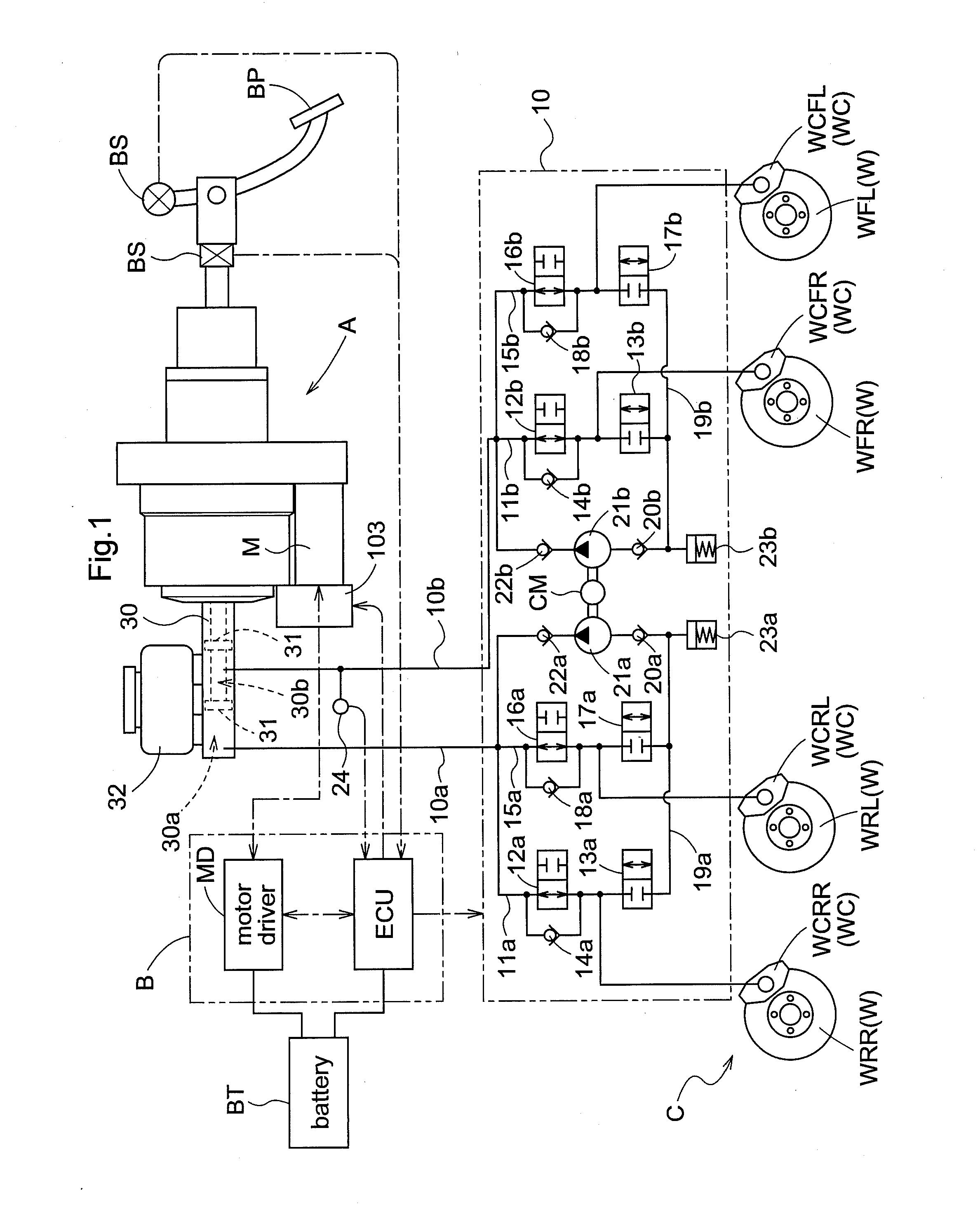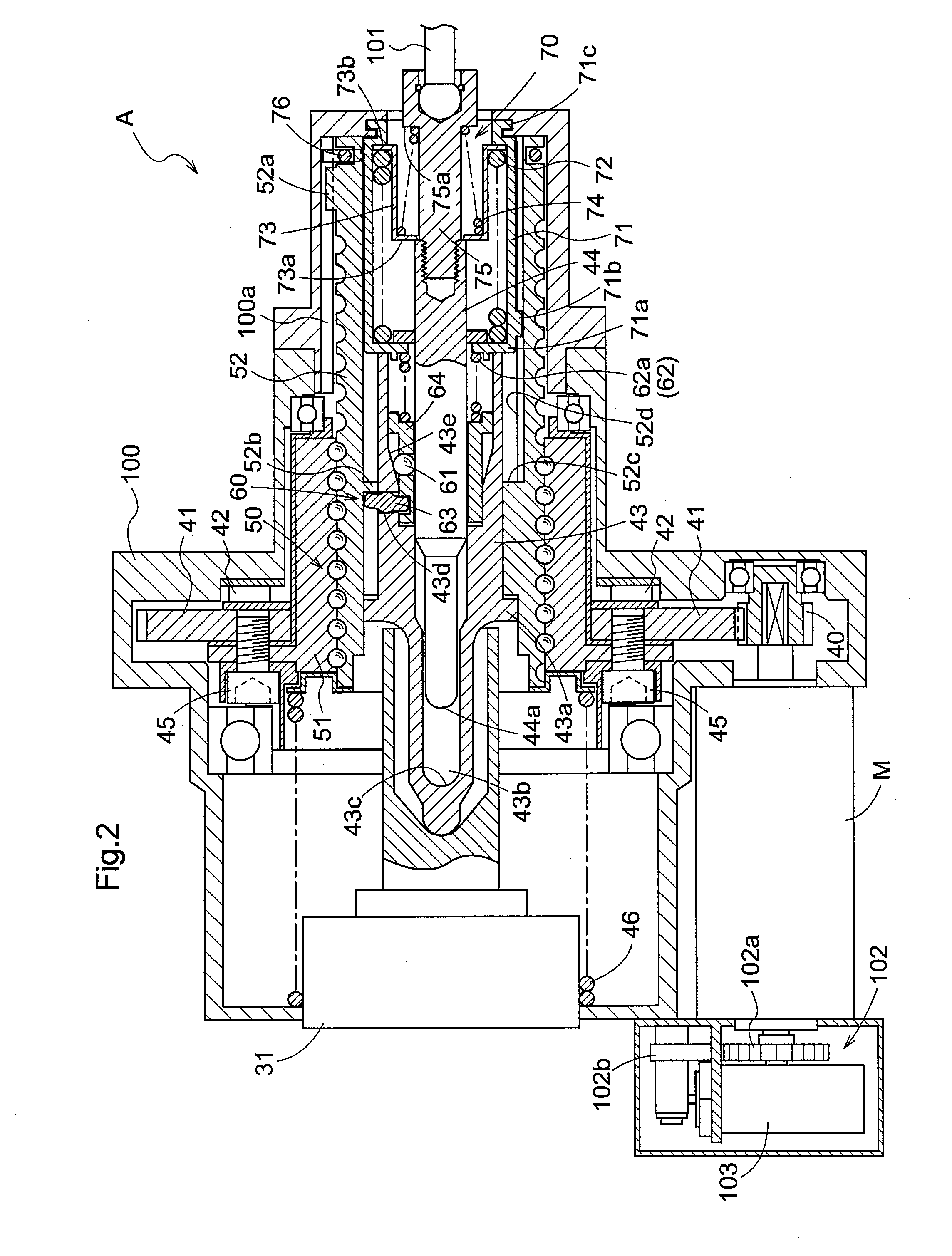Braking device
a technology of braking device and nut, which is applied in the direction of braking system, rotary clutch, fluid coupling, etc., can solve the problems of weak force to press the nut to the retracting limit, inability to perform satisfactory regenerative control, and transmission of members, so as to reduce the time lag during the brake operation
- Summary
- Abstract
- Description
- Claims
- Application Information
AI Technical Summary
Benefits of technology
Problems solved by technology
Method used
Image
Examples
first embodiment
[0035]A first embodiment of a braking device of the present invention will be described with reference to the drawings. The braking device of the present invention includes: a brake operation sensor BS configured to measure an operation amount of a brake pedal BP by a driver; a braking mechanism C actuatableconfigured to be actuated by a fluid pressure and to exert braking forces on wheels W; a hydraulic circuit 10 configured to transmit a fluid pressure to the braking mechanism C; a master cylinder 30 configured to generate a fluid pressure of brake oil in the hydraulic circuit 10; a master reservoir 32 configured to supply the brake oil to the master cylinder 30; a pressurizing mechanism A configured to generate a fluid pressure in the master cylinder 30 in accordance with an operation of the brake pedal BP; and a control unit B configured to apply a current to the pressurizing mechanism A in accordance with a measurement result by the brake operation sensor BS.
[0036]The braking m...
second embodiment
[0077]In the embodiment described above, when the braking device is not actuated, the input rod 44 and the output piston 43 are in a connected state by the function of the clutch mechanism 60. In addition, when the brake operation of emergency or the like is performed, the actuation of the motor M may delay behind the brake operation. In this case, the input rod 44 and the output piston 43 are in a connected state through the clutch mechanism 60, and the stroke simulator 70 is not locked to the housing 100. When the motor M is driven after the advance of the input rod 44, the connection of the input rod 44 and the output piston 43 is cancelled by the clutch mechanism 60. However, since the stroke simulator 70 is not locked to the housing 100, a reaction force is not generated, and an uncomfortable feeling is brought to a driver at this time point. The above-described configuration is provided for solving such a problem, but alternatively, the following control can be preformed in th...
third embodiment
[0084]In the embodiment described above, the biasing element 62 of the clutch mechanism 60 is fixed to the end wall 71a of the first casing 71. However, as shown in FIG. 7, a fixed member 65 may be present on the stroke simulator 70 side relative to the biasing element 62. The fixed member 65 is fixed to the other end of the output piston 43 by a fixing ring 66. In this configuration, the biasing element 62 is pinched between the fixed members 64 and 65 in a compressed state, and thus exerts forces in a stretching direction on both the fixed members 64 and 65. The force on the fixed member 64 serves as a force that biases the rolling element 61 to the tapered face 43e. On the other hand, the force on the fixed member 65 is cancelled out by a reaction force from the fixing ring 66. As a result, it becomes unnecessary to set an initial load of a return spring (not shown) in the master piston 31 to an initial load of the biasing element 62 or more, and thus the tread force during the d...
PUM
 Login to View More
Login to View More Abstract
Description
Claims
Application Information
 Login to View More
Login to View More - R&D
- Intellectual Property
- Life Sciences
- Materials
- Tech Scout
- Unparalleled Data Quality
- Higher Quality Content
- 60% Fewer Hallucinations
Browse by: Latest US Patents, China's latest patents, Technical Efficacy Thesaurus, Application Domain, Technology Topic, Popular Technical Reports.
© 2025 PatSnap. All rights reserved.Legal|Privacy policy|Modern Slavery Act Transparency Statement|Sitemap|About US| Contact US: help@patsnap.com



